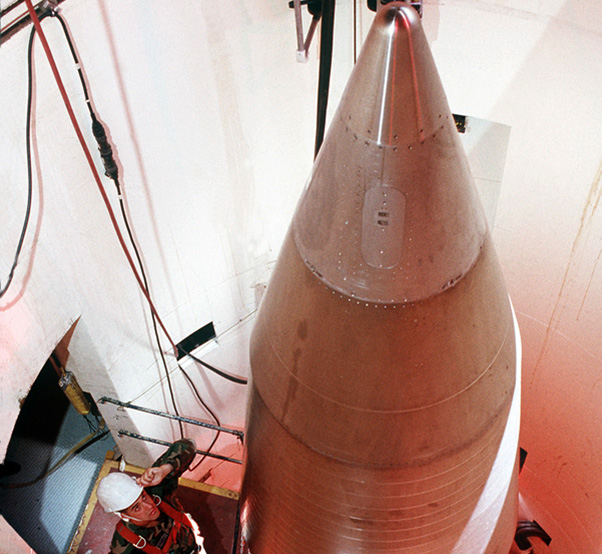By Charlie Vono, special to Aerotech News
Our old intercontinental ballistic missiles are being replaced by new ICBMs.
As a retired sustainment engineer who proudly kept our Minuteman III ICBMs viable for decades, I’ll share a bit about ICBMs and their mission, the old ICBMs, and the new one.
On Sept. 8. 2020, Northrop Grumman was awarded the prime contract for the Engineering and Manufacturing Development phase of our nation’s next ICBM. In case you are not familiar with our 400 Intercontinental Ballistic Missiles, you should know that within a moment’s notice, these land-based rockets can blast out of their protective underground silos and precisely deliver nuclear warheads to targets on the other side of the world. Together with sea-launched missiles and manned bombers, they form the “nuclear triad” which is intended to deter major adversaries, such as Russia, from direct attacks on our homeland or our allies.
“Deterrence Calculus” says that all three legs of the triad provide complementary deterrence. Manned bombers are recallable so can be used as diplomatic statements. Ground based rockets must be completely destroyed early by an adversary attacking the United States thus providing clarity of purpose and a threshold of stakes in this “game.”
And sea-launched missiles are undetectable and therefore create overwhelming doubt to an adversary concerning their ability to strike first. Of course, there is much, much more to deterrence math than that, but this gives you the basic idea of mutually supporting weapon systems each with unique capabilities.
This approach seems to have worked very well since the end of World War II to protect the U.S. homeland. The Northrop Grumman website, says:
“The U.S. Air Force’s Ground Based Strategic Deterrent is the weapon system replacement for the aging LGM-30 Minuteman III intercontinental ballistic missile system. GBSD represents the modernization of the ground-based leg of the nuclear triad.
The Minuteman III first became operational in the early 1970s. While certain components and subsystems have been upgraded, most of the fundamental infrastructure in use today is the original equipment supporting more than 50 years of continuous operation.”
The vast majority of this new missile GBSD activity has occurred since I retired from ICBM sustainment in 2014, so I speak from the unique position of not having any insight to the current, approved design. But I do speak from 25 years’ experience of sustaining our nation’s ICBM force and three years’ experience as an engineer in the Air Force Space Program.
So, apparently, sustaining Minuteman IIIs in the 21st century is no longer an option? The consensus is that a new missile is needed? WELL!! As a dedicated sustainer, I will deny with my last breath that a new missile must be fielded. As a sustainer I can always find ways to keep the old missile working. Me and my fellow sustainment team members on the Air Force and contractor sides were just that good at what we do.
For instance …
We have washed out the solid rocket motors and refilled them many times. Sometimes this required new casings and a few new nozzles — which was a pretty big engineering challenge! We replaced all the electronics in the Apollo-era guidance system at the turn of the last century. We re-furbished all the liquid fourth stages at that time as well. We constantly evaluated every piece and part looking for problems “lead time ahead” — which is measured in YEARS! The various ground and missile-based batteries of all types are a constant headache. The 100 various parts that safe, arm, disarm and squib various parts of the ground and missile systems have required perhaps the fewest upgrades. But they still had to analyzed and replaced as needed.
The business end of the missile, the reentry vehicle with the warhead, presented many unique challenges, not the least was the need to coordinate those activities with interested parties in the U.S. Navy and our allies. We did all of this and more, and we usually didn’t have all the design documentation we needed to analyze, upgrade and replace these parts and systems. There were many, many other challenges and we met them all.

On the other hand, with zero knowledge of the new design, I think I can still safely say that the half-century old guidance system, dependent right now on finicky spinning wheels of all kinds, will be replaced by smaller and more accurate solid-state versions. Maintenance will be needed less often and will be much easier to perform. The new solid rocket motors and their cases, based on 21st century materials, will be extremely reliable, long-lived, and easier to monitor and maintain. New and more reliable supply chains will be created. There will be more subtle changes such as more complete systems engineering models than we had, digital twins, and 21st century materials and processes.
Actually, come to think of it, I can’t wait to see what the new missile looks like and how its first flight goes.
Perhaps, perhaps after 50 years of stellar sustainment efforts, perhaps a new missile might be less expensive in the long run. And this does not consider any classified requirements that may have arisen in the areas of increased availability (also safe and sure), reliability, accuracy, or hardness against nuclear attack — which I no longer have any insight into.
These four “readiness factors” completely describe this weapon system’s ability to meet the nuclear deterrence mission.
Commonly available web searches indicate GBSD is expected to enter service around 2027, have many years of production, and remain in service until 2075.
If this brief article whets your appetite to be a part of this grand engineering adventure, it is not too late to go to the Northrop Grumman website and apply. But don’t forget their numerous partners, subcontractors, sub-subcontractors and vendors who are also hiring. They all have websites. And certainly, take a look at USAJOBS.GOV to see what our Air Force needs as it hires engineers and other specialties to monitor and manage Northrop Grumman’s efforts … and other new and legacy weapon systems.
Many of these jobs are here in my beautiful local area of Northern Utah near Hill AFB. But they exist around the country and certainly in your area. You can become a part of the nation’s mission of deterrence.
Oddly enough, elimination of nuclear weapons was part of our mission of sustaining these deterrence systems. And we did eliminate tens of thousands of “nukes” over the years. Having a credible deterrent actually helped in negotiations with other countries with similar capabilities.
Recall our history. It was way back during World War II that our Army Air Forces first clearly demonstrated that vast oceans no longer protect countries from devastating attack. We ended World War II with one bomb, one airplane, one city. This is what led directly to the Cold War Nuclear Deterrence Mission.
As you read this, think about how much time has passed since the end of World War II.
Consider a career not only in the nuclear deterrence mission, but also consider figuring out how we can completely eliminate nuclear weapons based on today’s technology and today’s world politics. Few experts are left who think that planetary asteroid defense needs nuclear bombs. Use of these weapons as a means to win a conflict makes no sense given their characteristic of leaving behind ecological disasters. Can deterrence of world wars be achieved via other means? What would that transition look like?
GBSD and nuclear de-escalation is a very worthy mission and life purpose.
Editor’s note: Retired U.S. Air Force Col. Charlie Vono’s career in the Air Force included Strategic Air Command pilot, and Space Program engineer. In his civilian career, he was a defense contractor sustainment engineer on ICBMs. This article represents only personal opinions.











